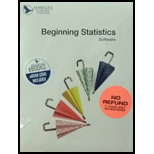
(a)
To State:
Null hypotheses and alternative hypotheses.
Answer to Problem 21E
Solution:
Null Hypotheses
Alternative Hypotheses
Explanation of Solution
Given:
A golf pro believes that the variances of his driving distances are different for different brands of golf balls. In particular, he believes that his driving distances, measured in yards, have a smaller variance when he uses Titleist golf balls than when he uses a generic store brand. He hits 10 Titleist golf balls and records a sample variance of 201.65. He hits 10 generic golf balls and records a sample variance of 364.57. Test the golf pro’s claim using a 0.05 level of significance.
Calculation:
Let population variances of the values of driving distances by the Titleist golf balls be represented by
(b)
The type of distribution to use for the test statistics and state the level of significance.
Answer to Problem 21E
Solution:
The F- test statistic is appropriate and the level of significance for this test is
Explanation of Solution
Given:
A golf pro believes that the variances of his driving distances are different for different brands of golf balls. In particular, he believes that his driving distances, measured in yards, have a smaller variance when he uses Titleist golf balls than when he uses a generic store brand. He hits 10 Titleist golf balls and records a sample variance of 201.65. He hits 10 generic golf balls and records a sample variance of 364.57. Test the golf pro’s claim using a 0.05 level of significance.
Calculation:
For comparing the variances of two
Therefore, the F-test statistic is appropriate and the level of significance for this test is
(c)
To Calculate:
The test statistic.
Answer to Problem 21E
Solution:
The test statistic is 0.5531.
Explanation of Solution
Given:
A golf pro believes that the variances of his driving distances are different for different brands of golf balls. In particular, he believes that his driving distances, measured in yards, have a smaller variance when he uses Titleist golf balls than when he uses a generic store brand. He hits 10 Titleist golf balls and records a sample variance of 201.65. He hits 10 generic golf balls and records a sample variance of 364.57. Test the golf pro’s claim using a 0.05 level of significance.
Formula used:
When the samples are given to be independent, the given population distribution are approximately normal, then the test statistics for the hypothesis test for two population variances is given by,
Where
The degree of freedom for the numerator is
The degree of freedom for the denominator is
Calculation:
Given
The Null Hypothesis is,
Alternative Hypotheses –
The test statistic value is given by,
Therefore, the test statistic is 0.5531.
(d)
To Draw:
The conclusion and interpret the decision.
Answer to Problem 21E
Solution:
The null hypothesis is accepted and it is concluded that there is a no sufficient evidence at the 0.05 level of significance to support the claim that variances of driving distances are different for different brands of golf balls.
Explanation of Solution
Given:
A golf pro believes that the variances of his driving distances are different for different brands of golf balls. In particular, he believes that his driving distances, measured in yards, have a smaller variance when he uses Titleist golf balls than when he uses a generic store brand. He hits 10 Titleist golf balls and records a sample variance of 201.65. He hits 10 generic golf balls and records a sample variance of 364.57. Test the golf pro’s claim using a 0.05 level of significance.
Formula used:
The null hypothesis is rejected if,
Calculation:
The level of significance
The degree of freedom for numerator is,
Substitute 10 for
The degree of freedom for denominator is,
Substitute 9 for
From the
By comparing the test statistic value and the critical value, the F value is greater than the critical value, so by the left tailed test the null hypothesis is accepted.
Conclusion:
Thus, there is no sufficient evidence at 0.05 level of significance to support the claim that the variances of driving distances are different for different brands of golf balls.
Want to see more full solutions like this?
Chapter 11 Solutions
BEGINNING STATISTICS-CD (NEW ONLY)
 MATLAB: An Introduction with ApplicationsStatisticsISBN:9781119256830Author:Amos GilatPublisher:John Wiley & Sons Inc
MATLAB: An Introduction with ApplicationsStatisticsISBN:9781119256830Author:Amos GilatPublisher:John Wiley & Sons Inc Probability and Statistics for Engineering and th...StatisticsISBN:9781305251809Author:Jay L. DevorePublisher:Cengage Learning
Probability and Statistics for Engineering and th...StatisticsISBN:9781305251809Author:Jay L. DevorePublisher:Cengage Learning Statistics for The Behavioral Sciences (MindTap C...StatisticsISBN:9781305504912Author:Frederick J Gravetter, Larry B. WallnauPublisher:Cengage Learning
Statistics for The Behavioral Sciences (MindTap C...StatisticsISBN:9781305504912Author:Frederick J Gravetter, Larry B. WallnauPublisher:Cengage Learning Elementary Statistics: Picturing the World (7th E...StatisticsISBN:9780134683416Author:Ron Larson, Betsy FarberPublisher:PEARSON
Elementary Statistics: Picturing the World (7th E...StatisticsISBN:9780134683416Author:Ron Larson, Betsy FarberPublisher:PEARSON The Basic Practice of StatisticsStatisticsISBN:9781319042578Author:David S. Moore, William I. Notz, Michael A. FlignerPublisher:W. H. Freeman
The Basic Practice of StatisticsStatisticsISBN:9781319042578Author:David S. Moore, William I. Notz, Michael A. FlignerPublisher:W. H. Freeman Introduction to the Practice of StatisticsStatisticsISBN:9781319013387Author:David S. Moore, George P. McCabe, Bruce A. CraigPublisher:W. H. Freeman
Introduction to the Practice of StatisticsStatisticsISBN:9781319013387Author:David S. Moore, George P. McCabe, Bruce A. CraigPublisher:W. H. Freeman





